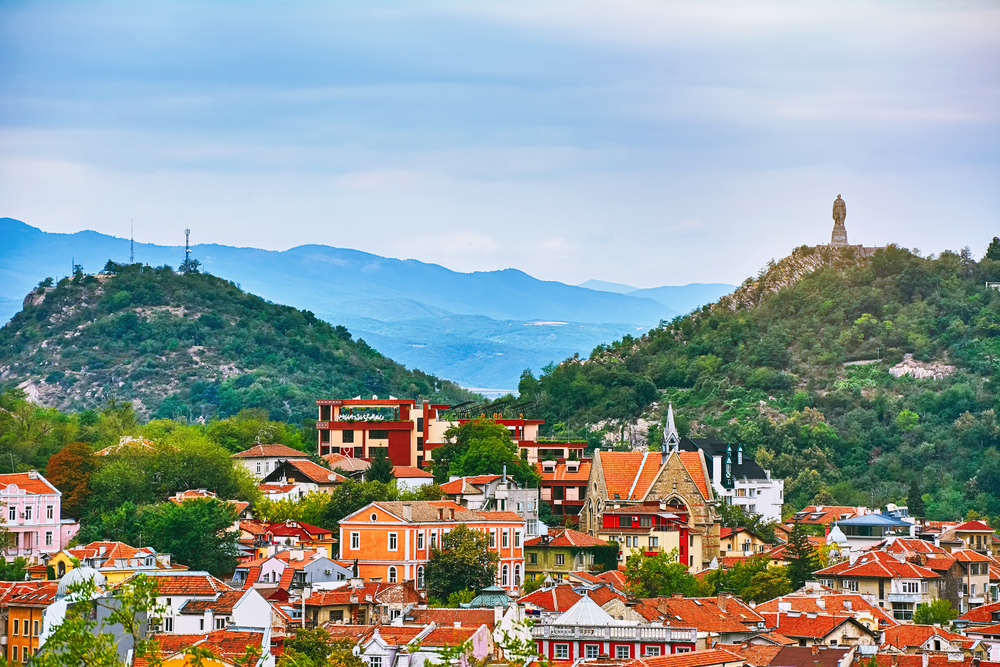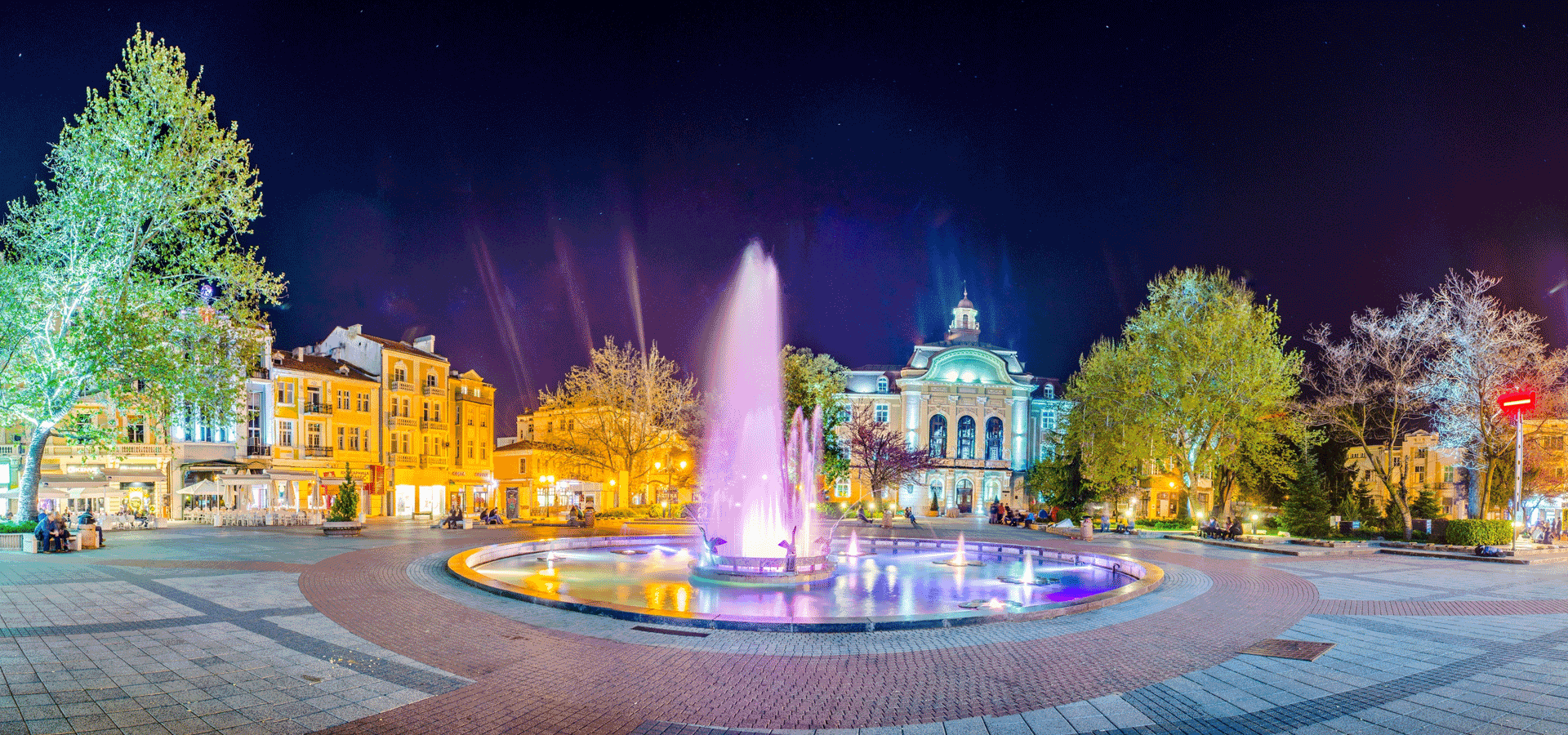Capital of Culture 2019
Bulgaria’s second city after the capital Sofia, Plovdiv, which features on UNESCO’s World Heritage list, is not just an elegant city with many historic attractions, but also an active cultural centre which in 2019 will also receive the title of Capital of Culture together with Matera.

Photo: Sisterscom.com, Shutterstock
Its charm has been compared to that of other beautiful and historic cities such as Florence and Paris, giving it the names of ‘Bulgarian Florence’ and ‘Paris of the Balkans’.

Ancient Forum. Photo: Sisterscom.com, Shutterstock
The Roman imprint
Even though the Bulgarian city of Plovdiv, which extends along the banks of the River Maritsa, boasts some eight thousand years of history (it is one of the oldest cities in Europe, a contemporary of Troy and Mycenae), the mark left by Roman rule is still evident at many important sites: the Amphitheatre, which holds between 5,000 and 7,000 spectators, the Roman Stadium, one of the best preserved on the planet, which holds some 30,000 people, the Ancient Forum, the Thermal Baths and various other archaeological sites from the same era.
The origins
The city’s origins date back to prehistory when it was a Thracian settlement. In the year 342 BC Philip II of Macedon, Alexander the Great’s father, conquered the settlement on the hill and in his honour the town became known as Philippopolis. For many years Plovdiv was the political and economic centre of Thracia until it was conquered by the Romans in the 1stcentury BC, changing its name to Trimontium. The old city of Plovdiv, in fact, sat on three hills: Nebet Tepe, which features an interesting archaeological complex, Taksim and Dzhambaz Tepe.

Photo: Sisterscom.com, Shutterstock
During the Roman era, under the emperor Marcus Aurelius, Trimontium became a splendid and important city; it also became the capital of Thracia and had the privilege of minting money, collections of which, in copper, silver and gold, can be found in the city’s museums.

Old city of Plovdiv. Photo: Sisterscom.com, Shutterstock
The old city
The old part of Plovdiv, in the heart of the city, which extends over the three hills, features spectacular buildings in the Bulgarian National Revival style, dating back to the nineteenth century, a period of economic and artistic splendour, with houses painted in various colours and attractive wooden balconies.

Kapana. Photo: Sisterscom.com, Shutterstock
Kapana
But one of the most interesting areas, considered a gem of the city and its true heart, is without doubt ‘Kapana’, a district whose name means ‘Trap’, in the sense that once you enter you’ll be captivated by the magical, warm and welcoming atmosphere and never want to leave.
This characteristic district is situated between the hills of Taksim and Nebet. It is devoted to modern creative industries, and is filled with shops, art galleries, workshops and art studios, as well as busy restaurants and coffee shops, and is set among a delightful labyrinth of cobbled streets with a festive atmosphere, highlighted by multi-coloured bunting hanging across the streets from balconies.
Each year Plovdiv holds one of the most important trade fairs in Europe, the International Industry Fair, which explains the city’s dedication to new industrial products.

Historical museum. Photo: Sisterscom.com, Shutterstock
Museums
But to discover more about the history of this lively modern city and its rich and complex past, a visit is essential to the Plovdiv Regional Archaeological Museum, which is filled with valuable treasures, including some of the most important Thracian items in Bulgaria, as well as the Ethnography Museum, which tells the story of the agricultural past of the country with items portraying everyday life and work in the fields.

Dzhumaya Mosque. Photo: Sisterscom.com, Shutterstock
Places of worship
The peaceful cohabitation of every religion is seen by the number of different places of worship:
- the Orthodox churches of St. Marina, St. Petka, St. Constantine and Helena with their exquisite icons;
- the Catholic Cathedral of St. Louis of France
- the small Basilica
- the nearby monasteries with their wonderful frescoes
- as well as the spectacular Islamic Dzhumaya Mosque.
All magnificent religious treasures, which highlight the rich, comprehensive past of this magical city, a clever combination of past and present, located in the centre of Thracia and waiting to be discovered.
Texts by Anna Glik
Photos: Sisterscom.com, Shutterstock
Copyright © Sisterscom.com
Video: www.bulgariatravel.org
Updated in June 2018
Tourism Board
www.visitplovdiv.com
www.bulgariatravel.org
Where to sleep in Plovdiv

Photo: Sisterscom.com, Shutterstock
Plovdiv is a welcoming city and offers different possibilities for accommodation.
To find the ideal hotel and the best offers you can do a search for the stars but also for districts or landmarks.
DISTRICTS
Hotels in the districts
LANDMARKS
Hotels in tourist areas
AIRPORT
Hotels near the airport
Where to go in plovdiv
Monuments

Photo: Sisterscom.com, Shutterstock
BALABANOV HOUSE
Balabanov House is a beautiful Bulgarian National Revival mansion. The last owner, the rich merchant Luka Balabanov who lived here, gave the place its name. It covers two floors: the lower floor was for trading purposes, the upper for living. It features important paintings that depict the cities with which the merchant did business.

Photo: Sisterscom.com, Shutterstock
ROMAN STADIUM
The Roman Stadium of Plovdiv dates back to the time of the Emperor Hadrian, in the second century AD. It is worth visiting for its majestic splendour and for the beauty of the main entrance, which features relief marble pillars and a bust of Hermes and the attributes of Hercules (mace and quiver) from the Roman period.

Photo: Sisterscom.com, Shutterstock
CATHEDRAL OF ST. LOUIS OF FRANCE
The Cathedral of St. Louis of France in Plovdiv, in Neoclassical and Baroque styles, is one of the largest and most important Catholic places of worship of the region. The interior is embellished with frescoes by the Bulgarian artist Kraskyo Stamatov and features an exceptional organ. Maria Luisa of Bourbon-Parma, the wife of Ferdinand I of Bulgaria, is buried here.

Photo: Sisterscom.com, Shutterstock
ARCHAEOLOGICAL SITES
Nebet Tepe is a site on one of Plovdiv’s hills, the place where the first town was founded. It features the walls of a fortress, towers, corridors and secret passages where it is said the apostle Paul walked. An archaeological complex of particular interest.

Photo: Sisterscom.com, Shutterstock
ROMAN AMPHITHEATRE
The Roman Amphitheatre of Plovdiv is one of the best preserved Roman constructions in the world. It has 28 concentric rows of seats and a large area for the orchestra. The theatre is still active and numerous festivals are held here, including the Folklore Festival, Jazz Festival and Opera Festival.

Photo: Sisterscom.com, Shutterstock
CHURCH OF SAINT CONSTANTINE
AND HELENA
The Church of St. Constantine and Helena is one of the most important attractions of the city and its oldest Christian place of worship. It was built in honour of Constantine the Great who with a decree granted religious freedom to all. He is portrayed here together with his mother Helena.
Museums

Photo: Sisterscom.com, Shutterstock
REGIONAL HISTORICAL MUSEUM
The Plovdiv Regional Historical Museum covers the history of Plovdiv from 15th to the 19th centuries, displaying the ethnic and economic diversity during this time in the city and region.
www.historymuseumplovdiv.org

Photo: Sisterscom.com, Shutterstock
REGIONAL ETHNOGRAPHIC MUSEUM
Situated in a house that was the property of Arghir Kuyumdzhiouglu, a splendid example of Bulgarian Baroque architecture with a façade of vivid colours, the museum covers four floors, has 130 windows and is the second largest museum in Bulgaria. Inside it features valuable furniture, frescoed rooms, carved balconies, paintings, traditional costumes, etc...
www.ethnograph.info

Photo: Sisterscom.com, Shutterstock
REGIONAL ARCHAEOLOGICAL MUSEUM
The Plovdiv Regional Archaeological Museum is an extraordinary museum and is brimming with Thracian, Greek and Roman art. It displays an important collection of 60,000 coins. It also contains a collection of 100,000 items from Plovdiv and its region: jewels, amulets, vases and gold cups, including those from the Panagyurishte Treasure.
www.archaeologicalmuseumplovdiv.org
Excursions

Photo: Sisterscom.com, Shutterstock
TSAR SIMEON GARDEN
The Tsar Simeon Garden of Plovdiv is a magnificent garden with rare plants, a Viennese pavilion and a central pond featuring a singing fountain with spectacular light effects and music. This luxuriant oasis is also well equipped for children with games and refreshment areas.

Photo: Sisterscom.com, Shutterstock
BACHKOVO MONASTERY
Bachkovo Monastery is Bulgaria’s second monastery for beauty and importance, and is located just a few miles from Plovdiv. It has is interesting architecturally and for its frescoes which cover the walls of the monastery and church.
Destinations found in the vicinity
Other destinations
Airports nearby Plovdiv








